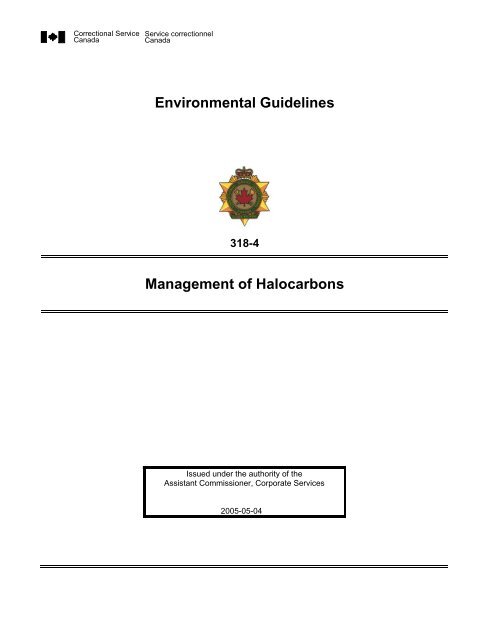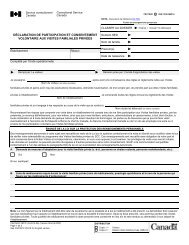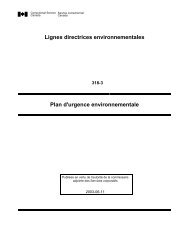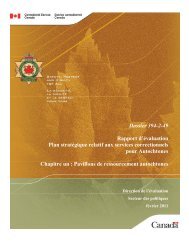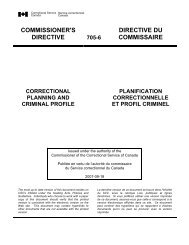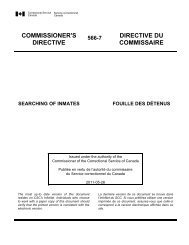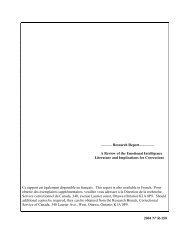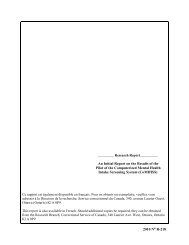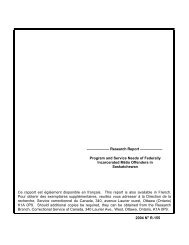Management of Halocarbons - Service correctionnel du Canada
Management of Halocarbons - Service correctionnel du Canada
Management of Halocarbons - Service correctionnel du Canada
Create successful ePaper yourself
Turn your PDF publications into a flip-book with our unique Google optimized e-Paper software.
Correctional <strong>Service</strong><br />
<strong>Canada</strong><br />
<strong>Service</strong> <strong>correctionnel</strong><br />
<strong>Canada</strong><br />
Environmental Guidelines<br />
318-4<br />
<strong>Management</strong> <strong>of</strong> <strong>Halocarbons</strong><br />
Issued under the authority <strong>of</strong> the<br />
Assistant Commissioner, Corporate <strong>Service</strong>s<br />
2005-05-04
Correctional <strong>Service</strong><br />
<strong>Canada</strong><br />
<strong>Service</strong> <strong>correctionnel</strong><br />
<strong>Canada</strong> EG 318-4 – <strong>Management</strong> <strong>of</strong> <strong>Halocarbons</strong><br />
TABLE OF CONTENTS<br />
PRIMARY GOAL 1<br />
SPECIFIC OBJECTIVES 1<br />
AUTHORITIES 1<br />
SECTION 1 – DEFINITIONS, RESPONSIBILITIES AND SCOPE 2<br />
SECTION 2 – GENERAL REQUIREMENTS 5<br />
SECTION 3 – SPECIFIC REQUIREMENTS 7<br />
SECTION 4 – DATA MANAGEMENT AND REPORTING 10<br />
SECTION 5 – REFERENCES AND AWARENESS 11<br />
SCHEDULE 1 – List <strong>of</strong> <strong>Halocarbons</strong> 12<br />
SCHEDULE 2 – Notice <strong>of</strong> Charging <strong>of</strong> a Chiller that has Undergone an Overhaul with a<br />
Halocarbon Listed in any <strong>of</strong> Items 1 to 9 <strong>of</strong> Sche<strong>du</strong>le 1<br />
SCHEDULE 3 – Inventory Information for Chillers, Refrigeration and Air-conditioning Systems 14<br />
SCHEDULE 4 – Leak Test Notice for Refrigeration and Air-conditioning Systems 15<br />
SCHEDULE 5 – Dismantling, Decommissioning or Destruction Notice for a System 16<br />
SCHEDULE 6 – Refrigeration System or Air-conditioning System <strong>Service</strong> Log 17<br />
SCHEDULE 7 – Halocarbon Release Report 18<br />
Environmental Programs, NHQ Page i 2005-05-04<br />
Page<br />
13
Correctional <strong>Service</strong><br />
<strong>Canada</strong><br />
PRIMARY GOAL<br />
To protect the stratospheric ozone layer.<br />
SPECIFIC OBJECTIVES<br />
<strong>Service</strong> <strong>correctionnel</strong><br />
<strong>Canada</strong> EG 318-4 – <strong>Management</strong> <strong>of</strong> <strong>Halocarbons</strong><br />
ENVIRONMENTAL GUIDELINES (EG) –<br />
MANAGEMENT OF HALOCARBONS<br />
Eliminate halocarbon emissions, i.e. ozone depleting substances – such as CFCs, HCFCs and halons –<br />
originating from federal installations (namely from chillers, refrigeration and air-conditioning systems that<br />
contain halocarbons) on federal lands.<br />
Formalize practices regarding the management <strong>of</strong> halocarbons, such that applicable proce<strong>du</strong>res and<br />
responsibilities are clearly established and compliant with federal and/or provincial requirements, and<br />
consistently implemented.<br />
Comply with the regulatory measures to achieve an orderly transition from CFCs contained in chillers,<br />
refrigeration and air-conditioning systems to alternative substances and technologies as per <strong>Canada</strong>’s<br />
Strategy to Accelerate the Phase-out <strong>of</strong> CFC and Halons Uses and to Dispose <strong>of</strong> the Surplus Stocks,<br />
2001.<br />
AUTHORITIES<br />
Correctional <strong>Service</strong> <strong>of</strong> <strong>Canada</strong> Commissioner's Directive 318 – Environmental Programs, June<br />
2003.<br />
Canadian Environmental Protection Act, 1999.<br />
Federal Halocarbon Regulations, 2003.<br />
Ozone-depleting Substances Regulations, 1998.<br />
Environment <strong>Canada</strong>, Environmental Protection <strong>Service</strong> – Environmental Code <strong>of</strong> Practice for<br />
Elimination <strong>of</strong> Fluorocarbon Emissions from Refrigeration and Air-conditioning Systems, March 1996.<br />
<strong>Canada</strong>’s Strategy to Accelerate the Phase-out <strong>of</strong> CFC and Halons Uses and to Dispose <strong>of</strong> the Surplus<br />
Stocks, CCME, May 2001.<br />
Environmental Programs, NHQ Page 1 2005-05-04
Correctional <strong>Service</strong><br />
<strong>Canada</strong><br />
<strong>Service</strong> <strong>correctionnel</strong><br />
<strong>Canada</strong> EG 318-4 – <strong>Management</strong> <strong>of</strong> <strong>Halocarbons</strong><br />
SECTION 1 – DEFINITIONS, RESPONSIBILITIES AND SCOPE<br />
The definitions in this section apply in these Environmental Guidelines. For additional definitions, please refer<br />
to the above-mentioned Regulations and Refrigerant Code <strong>of</strong> Practice.<br />
Air-conditioning system – An air-conditioning system, including any associated equipment, that contains or<br />
is designed to contain a halocarbon refrigerant.<br />
Appropriate container – In respect <strong>of</strong> an halocarbon management, a container that is designed and<br />
manufactured to be refilled and to contain a specific type <strong>of</strong> halocarbon.<br />
Brom<strong>of</strong>luorocarbon – A fully halogenated brom<strong>of</strong>luorocarbon each molecule <strong>of</strong> which contains one, two or<br />
three carbon atoms and at least one atom <strong>of</strong> bromine and one atom <strong>of</strong> fluorine.<br />
Certificate – A certificate recognized by three or more provinces, or by the province in which the work <strong>of</strong> the<br />
service technician who holds the certificate is being done, indicating successful completion <strong>of</strong> an<br />
environmental awareness course in recycling, recovery and handling proce<strong>du</strong>res <strong>of</strong> halocarbon<br />
refrigerants as outlined in the Refrigerant Code <strong>of</strong> Practice.<br />
Certified person – In respect <strong>of</strong> a refrigeration system or an air-conditioning system, a service technician<br />
who holds a certificate.<br />
Charging – Adding a halocarbon to a system (includes recharging or refilling).<br />
Chiller – An air-conditioning system or refrigeration system that has a compressor, an evaporator and a<br />
secondary refrigerant.<br />
Chlor<strong>of</strong>luorocarbon or CFC – A fully halogenated chlor<strong>of</strong>luorocarbon each molecule <strong>of</strong> which contains one,<br />
two or three carbon atoms and at least one atom <strong>of</strong> chlorine and one atom <strong>of</strong> fluorine.<br />
CPM – Chief, Plant Maintenance at the institutional level.<br />
CSC – Correctional <strong>Service</strong> <strong>of</strong> <strong>Canada</strong>.<br />
FHR – Federal Halocarbon Regulations, 2003.<br />
Halocarbon – A substance set out in Sche<strong>du</strong>le 1, whether existing alone or in a mixture, and includes<br />
isomers <strong>of</strong> any such substance. <strong>Halocarbons</strong> consist <strong>of</strong> a group <strong>of</strong> ozone depleting substances (mainly<br />
CFCs, halons and HCFCs) largely used in refrigeration and air-conditioning systems, some fire<br />
extinguishing systems and solvent systems.<br />
Hydrobrom<strong>of</strong>luorocarbon or HBFC – A hydrobrom<strong>of</strong>luorocarbon each molecule <strong>of</strong> which contains one, two<br />
or three carbon atoms and at least one atom <strong>of</strong> hydrogen, one atom <strong>of</strong> bromine and one atom <strong>of</strong><br />
fluorine.<br />
Hydrochlor<strong>of</strong>luorocarbon or HCFC – A hydrochlor<strong>of</strong>luorocarbon each molecule <strong>of</strong> which contains one, two<br />
or three carbon atoms and at least one atom <strong>of</strong> hydrogen, one atom <strong>of</strong> chlorine and one atom <strong>of</strong><br />
fluorine.<br />
Hydr<strong>of</strong>luorocarbon or HFC – A hydr<strong>of</strong>luorocarbon each molecule <strong>of</strong> which contains only carbon, hydrogen<br />
and fluorine atoms.<br />
Installation – Does not include the reactivation <strong>of</strong> a system by the same owner at the same site.<br />
Environmental Programs, NHQ Page 2 2005-05-04
Correctional <strong>Service</strong><br />
<strong>Canada</strong><br />
<strong>Service</strong> <strong>correctionnel</strong><br />
<strong>Canada</strong> EG 318-4 – <strong>Management</strong> <strong>of</strong> <strong>Halocarbons</strong><br />
Large system – A system containing halocarbons (CFCs, HCFCs, HFCs, blends, etc.) that has a<br />
refrigeration capacity over 19 kilowatts or 5.4 tons.<br />
Leak – The release <strong>of</strong> a halocarbon from a system.<br />
NHQ – National Headquarters <strong>of</strong> CSC.<br />
ODS – Ozone depleting substances.<br />
Overhaul – Includes the following proce<strong>du</strong>res or repair with regard to a system containing a halocarbon listed<br />
in any <strong>of</strong> items 1 to 9 <strong>of</strong> Sche<strong>du</strong>le 1:<br />
a) the replacement or modification <strong>of</strong> an internal sealing device;<br />
b) the replacement or modification <strong>of</strong> an internal mechanical part other than:<br />
i. an oil heater,<br />
ii. an oil pump,<br />
iii. a float assembly, or<br />
iv. a vane assembly, in the case <strong>of</strong> a chiller with single-stage compressor; or<br />
c) any proce<strong>du</strong>re or repair that resulted from the failure <strong>of</strong> an evaporator or a condenser heatexchanger<br />
tube.<br />
Owner – To hold a right in or to have possession, control or custody <strong>of</strong>, to be responsible for the<br />
maintenance, operation or management <strong>of</strong>, or to have the power to dispose <strong>of</strong> a system.<br />
Perfluorocarbon or PFC – A fully fluorinated fluorocarbon each molecule <strong>of</strong> which contains only carbon and<br />
fluorine atoms.<br />
Phase-out plan – In respect <strong>of</strong> halocarbon management, a gra<strong>du</strong>al replacement sche<strong>du</strong>le for halocarbons<br />
listed in any <strong>of</strong> items 1 to 9 <strong>of</strong> Sche<strong>du</strong>le 1, that is based on the age, condition and functional priority <strong>of</strong><br />
the systems involved. To the extent possible, the replacement sche<strong>du</strong>le should be implemented prior<br />
to the system failure or end <strong>of</strong> useful life.<br />
Recovery – In respect <strong>of</strong> a halocarbon, recovery means:<br />
a) collection after it has been used; or<br />
b) collection from machinery, equipment, a system or a container <strong>du</strong>ring servicing or before<br />
dismantling, decommissioning or destruction <strong>of</strong> the machinery, equipment, system or<br />
container.<br />
Reclamation – In respect <strong>of</strong> an halocarbon, the recovery, reprocessing and upgrading through processes<br />
such as filtering, drying, distilling and treating chemically in order to restore the halocarbon to in<strong>du</strong>stryaccepted<br />
reuse standards.<br />
Recycling – In respect <strong>of</strong> a halocarbon, the recovery and, if needed, cleaning by a process such as filtering<br />
or drying, and reusing to charge a system.<br />
Refrigerant Code <strong>of</strong> Practice – The Environmental Code <strong>of</strong> Practice for Elimination <strong>of</strong> Fluorocarbon<br />
Emissions from Refrigeration and Air-conditioning Systems, published by Environment <strong>Canada</strong> in<br />
March 1996, as amended from time to time.<br />
Refrigeration system – A refrigeration system, as well as any associated equipment, that contains or is<br />
designed to contain a halocarbon refrigerant.<br />
REO – Regional Environmental Officer in CSC.<br />
RHQ – Regional Headquarters <strong>of</strong> CSC.<br />
Environmental Programs, NHQ Page 3 2005-05-04
Correctional <strong>Service</strong><br />
<strong>Canada</strong><br />
<strong>Service</strong> <strong>correctionnel</strong><br />
<strong>Canada</strong> EG 318-4 – <strong>Management</strong> <strong>of</strong> <strong>Halocarbons</strong><br />
<strong>Service</strong> – Includes any modification, charging, maintenance, repair, moving, dismantling, decommissioning,<br />
destruction, start-up and testing <strong>of</strong> the system, but does not include testing related to the manufacture<br />
and pro<strong>du</strong>ction <strong>of</strong> the system.<br />
<strong>Service</strong> log – In respect <strong>of</strong> halocarbon management, the institutional service log book or maintenance<br />
records <strong>of</strong> refrigeration or air-conditioning system(s) in which the information [see Sche<strong>du</strong>le 6]<br />
concerning the work con<strong>du</strong>cted on system(s) is entered as it is being done.<br />
Small air-conditioning system – An air-conditioning system that is not contained in a motor vehicle and that<br />
has a refrigeration capacity <strong>of</strong> less than 19 kilowatts (5.4 tons) as rated by the manufacturer [see<br />
section 3.1 – Refrigerant Code <strong>of</strong> Practice].<br />
Small refrigeration system – A refrigeration system, other than one that normally operates in, on or in<br />
conjunction with a means <strong>of</strong> transportation, that has a refrigeration capacity <strong>of</strong> less than 19 kilowatts<br />
(5.4 tons) as rated by the manufacturer [see section 3.1 – Refrigerant Code <strong>of</strong> Practice].<br />
System – Unless the context requires otherwise, an air-conditioning system, a fire extinguishing system, a<br />
refrigeration system or a solvent system.<br />
RESPONSIBILITIES<br />
The Institutional Head, his or her assistants and the Corcan Operations Managers are accountable to<br />
ensure compliance with these Environmental Guidelines.<br />
The Chief, Plant Maintenance (CPM) will normally be the person responsible for the implementation and<br />
the follow-up <strong>of</strong> these Environmental Guidelines so that the inventory and the management <strong>of</strong> the<br />
halocarbons are assured from a central point in the institution [see note in section 3, page 8].<br />
The Chief, Plant Maintenance and his or her staff are responsible to inform all external contractors that<br />
are hired to work on institutional chillers, refrigeration and air-conditioning systems, so that they comply<br />
with the requirements set out in these Environmental Guidelines.<br />
SCOPE<br />
All Correctional <strong>Service</strong> <strong>of</strong> <strong>Canada</strong> facilities that manage, internally or through external contractors,<br />
chillers, refrigeration and/or air-conditioning systems containing halocarbons are submitted to these<br />
Environmental Guidelines.<br />
Note: Following surveys and audits con<strong>du</strong>cted across CSC, it was ascertained that CSC does not have any fireextinguishing<br />
system that contain halons or that is designed to contain a halocarbon fire-extinguishing agent nor any<br />
solvent system containing a halocarbon solvent. Consequently, the current Environmental Guidelines (EG 318-4)<br />
do not deal with the regulatory requirements (Federal Halocarbon Regulations, 2003) addressing the management<br />
<strong>of</strong> halons used in fire-extinguishing systems or halocarbons in solvent systems. The EG 318-4 focus only on the<br />
requirements concerning refrigeration systems and air-conditioning systems functioning with a halocarbon<br />
refrigerant.<br />
Environmental Programs, NHQ Page 4 2005-05-04
Correctional <strong>Service</strong><br />
<strong>Canada</strong><br />
SECTION 2 – GENERAL REQUIREMENTS<br />
PROHIBITIONS<br />
<strong>Service</strong> <strong>correctionnel</strong><br />
<strong>Canada</strong> EG 318-4 – <strong>Management</strong> <strong>of</strong> <strong>Halocarbons</strong><br />
1. No person shall release or allow or cause the release <strong>of</strong> a halocarbon that is contained in a<br />
refrigeration system, an air-conditioning system or any associated container or device [see<br />
section 2.9 – Refrigerant Code <strong>of</strong> Practice].<br />
2. No person shall install a system or purchase new equipment that operates or is intended to operate<br />
with a halocarbon listed in any <strong>of</strong> items 1 to 9 <strong>of</strong> Sche<strong>du</strong>le 1 (List <strong>of</strong> <strong>Halocarbons</strong>) unless authorized<br />
to do so by a permit issued under the FHR, 2003.<br />
3. No person shall store, transport or purchase a halocarbon unless it is in a container designed and<br />
manufactured to be refilled and to contain that specific type <strong>of</strong> halocarbon.<br />
4. No person shall charge an air-conditioning system that is designed for occupants in motor vehicles<br />
with a halocarbon listed in any <strong>of</strong> items 1 to 9 <strong>of</strong> Sche<strong>du</strong>le 1 [see section 4 – Refrigerant Code <strong>of</strong><br />
Practice].<br />
5. No person shall charge a refrigeration or an air-conditioning system with a halocarbon listed in any<br />
<strong>of</strong> items 1 to 9 <strong>of</strong> Sche<strong>du</strong>le 1.<br />
Note: A system operating with a halocarbon listed in any <strong>of</strong> items 1 to 9 <strong>of</strong> Sche<strong>du</strong>le 1 can be repaired and suitably<br />
modified to allow the use <strong>of</strong> alternative halocarbons (halocarbon listed in any items 10 to 12 <strong>of</strong> Sche<strong>du</strong>le 1). In case<br />
<strong>of</strong> damage or malfunction, these systems shall be disposed <strong>of</strong> in compliance with applicable regulations. If a<br />
refrigeration or an air-conditioning system is leaking, the remaining halocarbons must be recovered. The system<br />
must be either retr<strong>of</strong>itted or decommissioned. It is normal practice to decommission a system that cannot be<br />
retr<strong>of</strong>itted cost-effectively.<br />
6. Subject to paragraph 7 below, no person shall charge with a halocarbon listed in any items 1 to 9 <strong>of</strong><br />
Sche<strong>du</strong>le 1, a chiller that has undergone an overhaul (as defined in section 1).<br />
7. From January 1, 2005 to December 31, 2009, an owner <strong>of</strong> a chiller referred to in paragraph 6 above,<br />
may charge the chiller with a halocarbon listed in any <strong>of</strong> items 1 to 9 <strong>of</strong> Sche<strong>du</strong>le 1, but no person<br />
shall operate that chiller later than one year after the day on which it was charged, unless it no<br />
longer contains any halocarbon listed in any <strong>of</strong> those items. The owner <strong>of</strong> a chiller charged under<br />
these conditions shall provide written notice to the Minister (i.e. the appropriate regional division <strong>of</strong><br />
Environment <strong>Canada</strong>) within 14 days after the chiller is charged, which notice shall contain the<br />
information set out in Sche<strong>du</strong>le 2 (Notice <strong>of</strong> Charging <strong>of</strong> a Chiller that has Undergone an Overhaul<br />
with a Halocarbon Listed in any <strong>of</strong> Items 1 to 9 <strong>of</strong> Sche<strong>du</strong>le 1). A copy <strong>of</strong> this notice shall also be<br />
submitted in the same delay to the Regional Environmental Officer and the Environmental Programs<br />
Section at CSC-NHQ.<br />
8. Effective January 1, 2015, no person shall operate or permit the operation <strong>of</strong> any chiller that contains<br />
a halocarbon listed in any <strong>of</strong> items 1 to 9 <strong>of</strong> Sche<strong>du</strong>le 1.<br />
Environmental Programs, NHQ Page 5 2005-05-04
INVENTORY<br />
Correctional <strong>Service</strong><br />
<strong>Canada</strong><br />
<strong>Service</strong> <strong>correctionnel</strong><br />
<strong>Canada</strong> EG 318-4 – <strong>Management</strong> <strong>of</strong> <strong>Halocarbons</strong><br />
9. Each institution shall keep an up-to-date inventory <strong>of</strong> all refrigeration and air-conditioning systems<br />
and chillers containing halocarbons that have a refrigeration capacity over 19 kilowatts or 5.4 tons.<br />
To the extent possible, the inventory should also include small refrigeration and air-conditioning<br />
systems.<br />
10. The institutional inventory shall clarify and formalize the custody and maintenance arrangements for<br />
each system with a capacity over 19 kilowatts or 5.4 tons. Among other things, the inventory must<br />
uniquely identify and characterize each system, name its custodian, list the amount and type <strong>of</strong><br />
halocarbon it contains, and describe its maintenance and inspection arrangements. For each <strong>of</strong><br />
these systems, the inventory shall at least contain the information set out in Sche<strong>du</strong>le 3 (Inventory<br />
Information for Chillers, Refrigeration and Air-conditioning Systems).<br />
Environmental Programs, NHQ Page 6 2005-05-04
Correctional <strong>Service</strong><br />
<strong>Canada</strong><br />
SECTION 3 – SPECIFIC REQUIREMENTS<br />
<strong>Service</strong> <strong>correctionnel</strong><br />
<strong>Canada</strong> EG 318-4 – <strong>Management</strong> <strong>of</strong> <strong>Halocarbons</strong><br />
INSTALLATION, SERVICING, LEAK TESTING AND CHARGING<br />
1. Only a certified person may install, service, leak test or charge a halocarbon to a refrigeration or an<br />
air-conditioning system or do any other work on the system that may result in the release <strong>of</strong> a<br />
halocarbon. A person who does any <strong>of</strong> the work referred above shall do it in accordance with the<br />
Refrigerant Code <strong>of</strong> Practice.<br />
2. Any person who repairs or decommissions an apparatus that contains a halocarbon must be<br />
certified and properly equipped in case the proce<strong>du</strong>re causes the halocarbon to be released. The<br />
certified person must be appropriately equipped when assigned to leak test, repair, or decommission<br />
the parts <strong>of</strong> any apparatus that contain halocarbons.<br />
3. For each system with a capacity over 19 kilowatts or 5.4 tons, arrange for a certified person to<br />
con<strong>du</strong>ct a leak test at least once every 12 months, <strong>of</strong> all the components <strong>of</strong> a refrigeration or an airconditioning<br />
system that come into contact with a halocarbon, confirm that the system meets all<br />
current design criteria and that the installation is equipped with halocarbon leak sensors if required<br />
by regulation [see section 2.6.6 – Refrigerant Code <strong>of</strong> Practice].<br />
4. A certified person who repairs and/or con<strong>du</strong>cts a leak test on a refrigeration or an air-conditioning<br />
system shall place a permanent notice (label) on the system containing the information set out in<br />
Sche<strong>du</strong>le 4 (Leak Test Notice for Refrigeration and Air-conditioning System). In addition:<br />
a) No person shall remove this notice except to replace it with another such notice.<br />
b) The owner shall keep a record <strong>of</strong> the information contained in the notice in the Refrigeration and<br />
Air-conditioning System <strong>Service</strong> Log [see section 2.7.4 – Refrigerant Code <strong>of</strong> Practice].<br />
5. No person shall charge a refrigeration or air-conditioning system unless the system has been leak<br />
tested before charging and any leak has been repaired.<br />
6. If a halocarbon leak is detected at any time, the assigned responsible person shall, through the<br />
service <strong>of</strong> a certified person:<br />
a) immediately repair the leaking portion <strong>of</strong> the system; or<br />
b) if repairs are not likely to be initiated within seven days, immediately isolate the leaking portion <strong>of</strong><br />
the system and recover the halocarbons from the leaking portion <strong>of</strong> the system pending repair <strong>of</strong><br />
the leak with respect to approved practices in this field.<br />
Environmental Programs, NHQ Page 7 2005-05-04
RECOVERY<br />
Correctional <strong>Service</strong><br />
<strong>Canada</strong><br />
<strong>Service</strong> <strong>correctionnel</strong><br />
<strong>Canada</strong> EG 318-4 – <strong>Management</strong> <strong>of</strong> <strong>Halocarbons</strong><br />
7. A certified person that installs, services, leak tests or charges a halocarbon to a refrigeration or an<br />
air-conditioning system, or that does any other work on any <strong>of</strong> those systems that may result in the<br />
release <strong>of</strong> a halocarbon, shall recover, into an appropriate container, any halocarbon that would<br />
otherwise be released <strong>du</strong>ring those proce<strong>du</strong>res [see sections 2.10 and 3.5 – Refrigerant Code <strong>of</strong><br />
Practice].<br />
8. Before dismantling, decommissioning or disposing <strong>of</strong> any system, a person shall:<br />
a) recover halocarbons into an appropriate container and dispose <strong>of</strong> as hazardous waste [see<br />
sections 2.9 and 3.4 to 3.8 – Refrigerant Code <strong>of</strong> Practice];<br />
b) place a notice (label) on the system containing the information set out in Sche<strong>du</strong>le 5 –<br />
Dismantling, Decommissioning or Destruction Notice for a System (note that no person shall<br />
remove this notice except to replace it with another such notice); and<br />
c) once the decommissioning is completed, ensure that the dismantled system can never be<br />
reused.<br />
9. In case <strong>of</strong> the dismantling, disposing or decommissioning <strong>of</strong> any system, a record <strong>of</strong> the information<br />
contained in this notice (label) shall be kept on site in the service log [see Sche<strong>du</strong>le 6 –<br />
Refrigeration System and Air-conditioning System <strong>Service</strong> Log].<br />
Note: At CSC, systems with a capacity over 19 kilowatts or 5.4 tons are <strong>of</strong>ten in the custody <strong>of</strong> responsibility centers like<br />
Food <strong>Service</strong>s, Corcan, and Plant Maintenance, each <strong>of</strong> which may have a contract with a different external supplier to<br />
service its machines. It is suggested that the Maintenance <strong>Management</strong> System (MMS) operated by the Chief <strong>of</strong> Plant<br />
Maintenance (CPM) be used to issue a work order to record the test results <strong>of</strong> the inspections that are required by law for<br />
each system with a capacity over 19 kilowatts or 5.4 tons, whether or not it is in CPM custody. Additionally, it is<br />
suggested that each non-CPM custodian establish a proce<strong>du</strong>re to ensure that the results <strong>of</strong> all other inspections and<br />
repairs to their systems are recorded in the MMS and in the service log.<br />
REQUIREMENTS FOR SMALL SYSTEMS<br />
10. When dismantling, disposing or decommissioning <strong>of</strong> equipment that contains a small system (i.e.<br />
with a refrigeration capacity <strong>of</strong> less than 19 kilowatts or 5.4 tons such as the one in a motor vehicle,<br />
refrigerator or water cooler), the parts <strong>of</strong> the apparatus that contain halocarbon must be<br />
decommissioned before disposal. However, when selling or transferring used equipment containing<br />
a small system that a new owner is expected to continue to operate, it is not necessary to<br />
decommission the small system unless it leaks while in CSC custody.<br />
11. Arrange for a certified person to recover the halocarbons from any small system in which a<br />
halocarbon leak has been discovered, or which is being decommissioned (dismantled or disposed).<br />
In this situation, place a notice (label) on the small system containing the information set out in<br />
Sche<strong>du</strong>le 5 (Dismantling, Decommissioning or Destruction Notice for a System). No person shall<br />
remove this notice except to replace it with another such notice. Record the information set out in<br />
Sche<strong>du</strong>le 6 (Refrigeration System and Air-conditioning System <strong>Service</strong> Log) when a small system is<br />
purged.<br />
Environmental Programs, NHQ Page 8 2005-05-04
Correctional <strong>Service</strong><br />
<strong>Canada</strong><br />
<strong>Service</strong> <strong>correctionnel</strong><br />
<strong>Canada</strong> EG 318-4 – <strong>Management</strong> <strong>of</strong> <strong>Halocarbons</strong><br />
PHASE-OUT OF HALOCARBONS LISTED IN ANY ITEMS 1 TO 9 OF SCHEDULE 1<br />
12. According to the requirements set-out in section 2, paragraphs 5 to 7, as <strong>of</strong> January 1, 2005, the<br />
owners <strong>of</strong> refrigeration or air-conditioning systems containing a halocarbon listed in any <strong>of</strong> items 1<br />
to 9 <strong>of</strong> Sche<strong>du</strong>le 1 must develop and implement, no later than a year after the adoption <strong>of</strong> these<br />
Environmental Guidelines, a phase-out plan, i.e. a gra<strong>du</strong>al replacement sche<strong>du</strong>le for the<br />
halocarbons listed in any <strong>of</strong> items 1 to 9 <strong>of</strong> Sche<strong>du</strong>le 1. The phase-out plan should be based on the<br />
age, condition and functional priority <strong>of</strong> the systems involved. The owners should consider that this<br />
replacement sche<strong>du</strong>le could change or be advance in time in the event <strong>of</strong> a halocarbon leak from a<br />
system or if a system overhaul/repair becomes required.<br />
13. According to the requirements set-out in section 2, paragraphs 8 and 9, a phase-out plan or retr<strong>of</strong>it<br />
sche<strong>du</strong>le for chillers containing a halocarbon listed in any <strong>of</strong> items 1 to 9 <strong>of</strong> Sche<strong>du</strong>le 1 must also be<br />
developed and implemented based on the chiller age, condition and functional priority <strong>of</strong> the<br />
targeted systems. The phase-out or retr<strong>of</strong>it <strong>of</strong> chillers will have to be implemented between 2005<br />
and 2015 for no chiller may contain a halocarbon listed in any <strong>of</strong> items 1 to 9 <strong>of</strong> Sche<strong>du</strong>le 1 beyond<br />
January 1, 2015.<br />
Environmental Programs, NHQ Page 9 2005-05-04
Correctional <strong>Service</strong><br />
<strong>Canada</strong><br />
<strong>Service</strong> <strong>correctionnel</strong><br />
<strong>Canada</strong> EG 318-4 – <strong>Management</strong> <strong>of</strong> <strong>Halocarbons</strong><br />
SECTION 4 – DATA MANAGEMENT AND REPORTING<br />
RECORDS<br />
1. Whenever a refrigeration or air-conditioning system is decommissioned, a written record containing<br />
the information set out in Sche<strong>du</strong>le 5 (Dismantling, Decommissioning or Destruction Notice for a<br />
System) shall be kept on site in the service log.<br />
2. Whenever a refrigeration or air-conditioning system is installed, serviced, leak tested, repaired or<br />
charged, a written record containing the information set out in Sche<strong>du</strong>le 6 (Refrigeration System<br />
and Air-conditioning System <strong>Service</strong> Log) shall be kept on site.<br />
3. The institutional phase-out plan, i.e. the gra<strong>du</strong>al replacement sche<strong>du</strong>le, for refrigeration and airconditioning<br />
systems containing a halocarbon listed in any <strong>of</strong> items 1 to 9 <strong>of</strong> Sche<strong>du</strong>le 1 shall be<br />
kept on site and available at all time for review by RHQ and/or NHQ staff.<br />
4. All the documents required in these Environmental Guidelines (in particular, records, service logs,<br />
reports, notices or other relevant documents) shall be kept on site in the form <strong>of</strong> a central register <strong>of</strong><br />
halocarbons or integrated to the Environmental Information System (EIS), for a period <strong>of</strong> at least<br />
10 years beginning on the date <strong>of</strong> their issuance [see section 2.11 – Refrigerant Code <strong>of</strong> Practice].<br />
RELEASE REPORTS<br />
5. In the event <strong>of</strong> an accidental release <strong>of</strong> 100 kg or more <strong>of</strong> any halocarbon, the following reports shall<br />
be submitted to:<br />
• the appropriate Regional Division <strong>of</strong> Environment <strong>Canada</strong> (in priority),<br />
• the Regional Environmental Officer (REO), and<br />
• the Environmental Programs Section at CSC-National Headquarters (CSC-NHQ),<br />
a) within 24 hours after the day on which the release is detected, a verbal or written report that<br />
indicates the type <strong>of</strong> halocarbon released and the type <strong>of</strong> system from which it was released;<br />
b) within 14 days after the day on which the release is detected, a written report that indicates the<br />
information set out in Sche<strong>du</strong>le 7 (Halocarbon Release Report).<br />
6. If more than 10 kg but less than 100 kg <strong>of</strong> a halocarbon is released, written reports that contain the<br />
information set out in Sche<strong>du</strong>le 7 (Halocarbon Release Report) shall be submitted twice a year<br />
(mid-July and mid-January) to the Regional Environmental Officer (REO). The REO will then<br />
forward these reports to the Environmental Programs Section at CSC-NHQ so that NHQ submits<br />
semi-annual corporate reports to the appropriate Regional Division <strong>of</strong> Environment <strong>Canada</strong>.<br />
Environmental Programs, NHQ Page 10 2005-05-04
Correctional <strong>Service</strong><br />
<strong>Canada</strong><br />
<strong>Service</strong> <strong>correctionnel</strong><br />
<strong>Canada</strong> EG 318-4 – <strong>Management</strong> <strong>of</strong> <strong>Halocarbons</strong><br />
SECTION 5 – REFERENCES AND AWARENESS<br />
1. For more information on issues related to halocarbons, refer to Environment <strong>Canada</strong> infonet site<br />
(Stratospheric Ozone home page) at: http://www.ec.gc.ca/ozone/.<br />
2. For halocarbon regulations and compliance guides:<br />
http://www.ec.gc.ca/ozone/EN/regulations/index.cfm?intCat=1.<br />
3. For Federal Halocarbon Regulations, 2003:<br />
http://laws.justice.gc.ca/en/C-15.31/SOR-2003-289/68957.html.<br />
4. For the Ozone-depleting Substances Regulations, 1998:<br />
http://laws.justice.gc.ca/en/c-15.31/sor-99-7/text.html.<br />
5. For the Canadian Environmental Protection Act, 1999:<br />
http://laws.justice.gc.ca/en/C-15.31/29338.html.<br />
6. Environmental Code <strong>of</strong> Practice for Elimination <strong>of</strong> Fluorocarbon Emissions from Refrigeration and<br />
Air-conditioning Systems, Report EPS 1/RA/2, Environment <strong>Canada</strong>, March 1996.<br />
ISBN 0-660-95256-4. Cat. No. En49-26/1-2E.<br />
7. <strong>Canada</strong>’s Strategy to Accelerate the Phase-out <strong>of</strong> CFC and Halons Uses and to Dispose <strong>of</strong> the<br />
Surplus Stocks, CCME, May 2001: http://www.ec.gc.ca/ozone/EN/init/index.cfm?intCat=43.<br />
Assistant Commissioner,<br />
Corporate <strong>Service</strong>s<br />
Original signed by:<br />
Louise Saint-Laurent<br />
Environmental Programs, NHQ Page 11 2005-05-04
Correctional <strong>Service</strong><br />
<strong>Canada</strong><br />
List <strong>of</strong> <strong>Halocarbons</strong><br />
Item Halocarbon<br />
<strong>Service</strong> <strong>correctionnel</strong><br />
<strong>Canada</strong> EG 318-4 – <strong>Management</strong> <strong>of</strong> <strong>Halocarbons</strong><br />
SCHEDULE 1<br />
List <strong>of</strong> <strong>Halocarbons</strong><br />
Extract from Sche<strong>du</strong>le 1 <strong>of</strong> the Federal Halocarbon Regulations, 2003<br />
1. Tetrachloromethane (carbon tetrachloride)<br />
2. 1,1,1-trichloroethane (methyl chlor<strong>of</strong>orm), not including 1,1,2-trichloroethane<br />
3. Chlor<strong>of</strong>luorocarbons (CFC)<br />
4. Bromochlorodifluoromethane (Halon 1211)<br />
5. Bromotrifluoromethane (Halon 1301)<br />
6. Dibromotetrafluoroethane (Halon 2402)<br />
7. Brom<strong>of</strong>luorocarbons other than those set out in items 4 to 6<br />
8. Bromochloromethane (Halon 1011)<br />
9. Hydrobrom<strong>of</strong>luorocarbons (HBFC)<br />
10. Hydrochlor<strong>of</strong>luorocarbons (HCFC)<br />
11. Hydr<strong>of</strong>luorocarbons (HFC)<br />
12. Perfluorocarbons (PFC)<br />
Note: As prescribed in the present document, the requirements affecting the items in the yellow shaded area<br />
are more restrictive because <strong>of</strong> the important ozone layer depletion potential <strong>of</strong> these halocarbons.<br />
Environmental Programs, NHQ Page 12 2005-05-04
Correctional <strong>Service</strong><br />
<strong>Canada</strong><br />
<strong>Service</strong> <strong>correctionnel</strong><br />
<strong>Canada</strong> EG 318-4 – <strong>Management</strong> <strong>of</strong> <strong>Halocarbons</strong><br />
SCHEDULE 2<br />
Notice 1 <strong>of</strong> Charging <strong>of</strong> a Chiller that has Undergone an Overhaul<br />
with a Halocarbon Listed in any <strong>of</strong> Items 1 to 9 <strong>of</strong> Sche<strong>du</strong>le 1<br />
(A notice or label is to be placed on the system and a copy in the service log.)<br />
1 Form CSC/SCC 1265-01B is available on the infonet at: http://infonet/forms/forms/1265-01B.doc.<br />
Environmental Programs, NHQ Page 13 2005-05-04
Correctional <strong>Service</strong><br />
<strong>Canada</strong><br />
Institution:<br />
<strong>Service</strong> <strong>correctionnel</strong><br />
<strong>Canada</strong> EG 318-4 – <strong>Management</strong> <strong>of</strong> <strong>Halocarbons</strong><br />
SCHEDULE 3<br />
Inventory Information for Chillers, Refrigeration and Air-conditioning Systems<br />
Inventory <strong>of</strong> chillers, refrigeration<br />
System Identification Code<br />
and air-conditioning systems Serial no. Serial no. Serial no. Serial no.<br />
Building no. where the system is located<br />
Location (name and/or room no.)<br />
System make<br />
System model<br />
Date <strong>of</strong> manufacture <strong>of</strong> system<br />
Description <strong>of</strong> system (type <strong>of</strong> system)<br />
Capacity <strong>of</strong> system (kW or tons)<br />
Type <strong>of</strong> halocarbon<br />
Quantity <strong>of</strong> halocarbon (kg or lbs)<br />
Remarks<br />
Environmental Programs, NHQ Page 14 2005-05-04
Correctional <strong>Service</strong><br />
<strong>Canada</strong><br />
<strong>Service</strong> <strong>correctionnel</strong><br />
<strong>Canada</strong> EG 318-4 – <strong>Management</strong> <strong>of</strong> <strong>Halocarbons</strong><br />
SCHEDULE 4<br />
Leak Test Notice 2 for Refrigeration and Air-conditioning System<br />
(A notice or label is to be placed on the system and a copy in the service log.)<br />
2 Form CSC/SCC 1265-01C is available on the infonet at: http://infonet/forms/forms/1265-01C.doc.<br />
Environmental Programs, NHQ Page 15 2005-05-04
Correctional <strong>Service</strong><br />
<strong>Canada</strong><br />
<strong>Service</strong> <strong>correctionnel</strong><br />
<strong>Canada</strong> EG 318-4 – <strong>Management</strong> <strong>of</strong> <strong>Halocarbons</strong><br />
SCHEDULE 5<br />
Dismantling, Decommissioning or Destruction Notice 3 for a System<br />
(A notice or label is to be placed on the system and a copy in the service log.)<br />
3 Form CSC/SCC 1265-01D is available on the infonet at: http://infonet/forms/forms/1265-01D.doc.<br />
Environmental Programs, NHQ Page 16 2005-05-04
Correctional <strong>Service</strong><br />
<strong>Canada</strong><br />
<strong>Service</strong> <strong>correctionnel</strong><br />
<strong>Canada</strong> EG 318-4 – <strong>Management</strong> <strong>of</strong> <strong>Halocarbons</strong><br />
SCHEDULE 6<br />
Refrigeration System or Air-conditioning System <strong>Service</strong> Log 4<br />
4 Form CSC/SCC 1265-01E is available on the infonet at: http://infonet/forms/forms/1265-01E.doc.<br />
Environmental Programs, NHQ Page 17 2005-05-04
Correctional <strong>Service</strong><br />
<strong>Canada</strong><br />
<strong>Service</strong> <strong>correctionnel</strong><br />
<strong>Canada</strong> EG 318-4 – <strong>Management</strong> <strong>of</strong> <strong>Halocarbons</strong><br />
SCHEDULE 7<br />
Halocarbon Release Report 5<br />
5 Form CSC/SCC 1265-01A is available on the infonet at: http://infonet/forms/forms/1265-01A.doc.<br />
Environmental Programs, NHQ Page 18 2005-05-04


